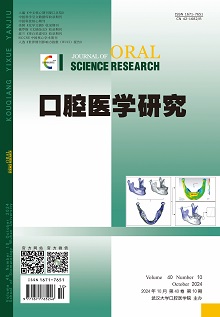|
|
Clinical Study on Celecoxib Preemptive Analgesia Combined with Nitrous Oxide Inhalation for Extraction of Mandibular Impacted Third Molar Teeth
CHEN Ziyao, LIU Chang, LI Min, ZU Wenxuan, LIAO Shengkai, WANG Huixian, CHEN Yongfeng
2024, 40(10):
900-904.
DOI: 10.13701/j.cnki.kqyxyj.2024.10.010
Objective: To evaluate the clinical effect of celecoxib preemptive analgesia combined with nitrous oxide sedation in the extraction of mandibular impacted third molar teeth. Methods: A total of 120 patients who had unilateral impacted mandibular third molar were selected and divided into control group, nitrous oxide group, celecoxib group, and experimental group with 30 cases in each group. Control group was performed minimally invasive tooth extraction. Nitrous oxide group was inhaled nitrous oxide for tooth extraction. Celecoxib group received oral celecoxib 0.4 g for tooth extraction 30 minutes before surgery. The experimental group took celecoxib 0.4 g orally 30min before surgery, and then used nitrous oxide inhalation system for tooth extraction. Local anesthesia intraoperative and 2, 4, 6, 12, 24, 48 h postoperative visual analogue scale (VAS) scores were recorded. Modified dental anxiety scale (MDAS) before and after surgery were recorded. The interval of first analgesic administration 48 h after surgery and the total dose, mean arterial pressure (MAP) and heart rate (HR) in T0 (5 min before surgery), T1 (local anesthesia), T2 (tooth extraction), and T3 (5 min after surgery) were also recorded. Results: Compared with the control group, the scores of 4 and 6 h VAS in celecoxib group, the scores of local anesthesia and VAS during operation in nitrous oxide group, and the scores of local anesthesia, during operation, and 4 and 6 h VAS after operation in experimental group were significantly decreased (P<0.05). Compared with celecoxib group, the scores of local anesthesia and operative VAS in nitrous oxide group were significantly decreased, and those in experimental group were significantly decreased (P<0.05). Compared with nitrous oxide group, the 4 and 6 h VAS scores of experimental groups were significantly decreased (P<0.05). Postoperative MDAS scores of four groups were lower than those before surgery, and there was no statistical significance between preoperative and postoperative MDAS scores (P>0.05). Compared with the control group, the duration of drug administration between celecoxib group and experimental group was significantly increased, and the dose was significantly decreased (P<0.05). Compared with nitrous oxide group, the duration of drug administration in celecoxib group and experimental group was significantly increased, and the dose was significantly decreased (P<0.05). Compared with the control group, MAP and HR of the other three groups showed no statistical significance at T0, while node differences were statistically significant at other times (P<0.05). Conclusion: Celecoxib advanced analgesia combined with nitrous oxide sedation and analgesia has significant analgesic effect in mandibular impacted third molar extraction, which can reduce postoperative pain and the use of emergency analgesic drugs, reduce intraoperative blood pressure fluctuation of patients, and improve the comfort of diagnosis and treatment.
References |
Related Articles |
Metrics
|

